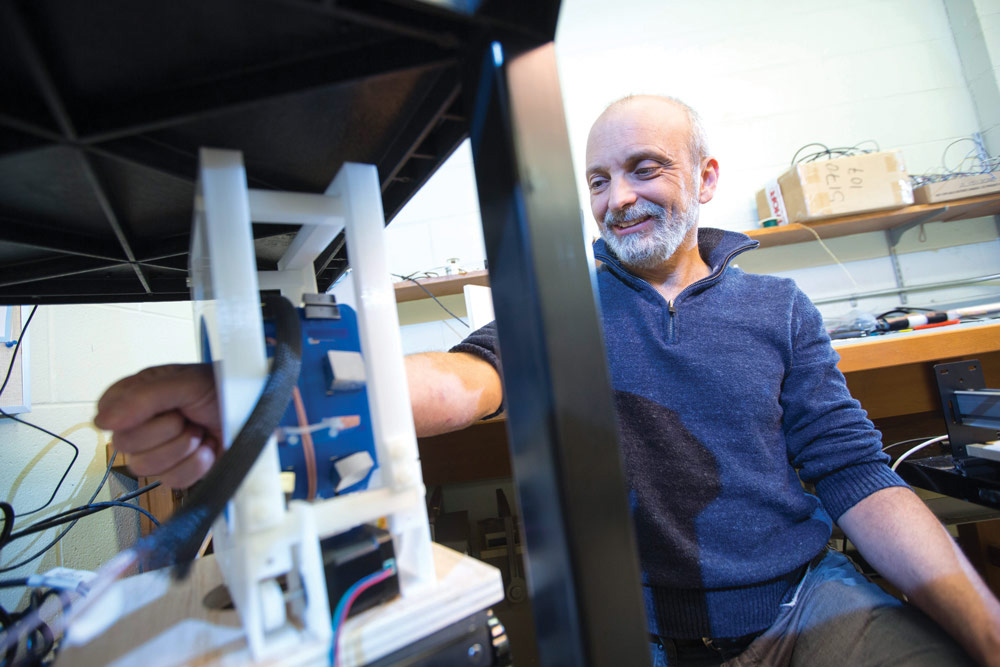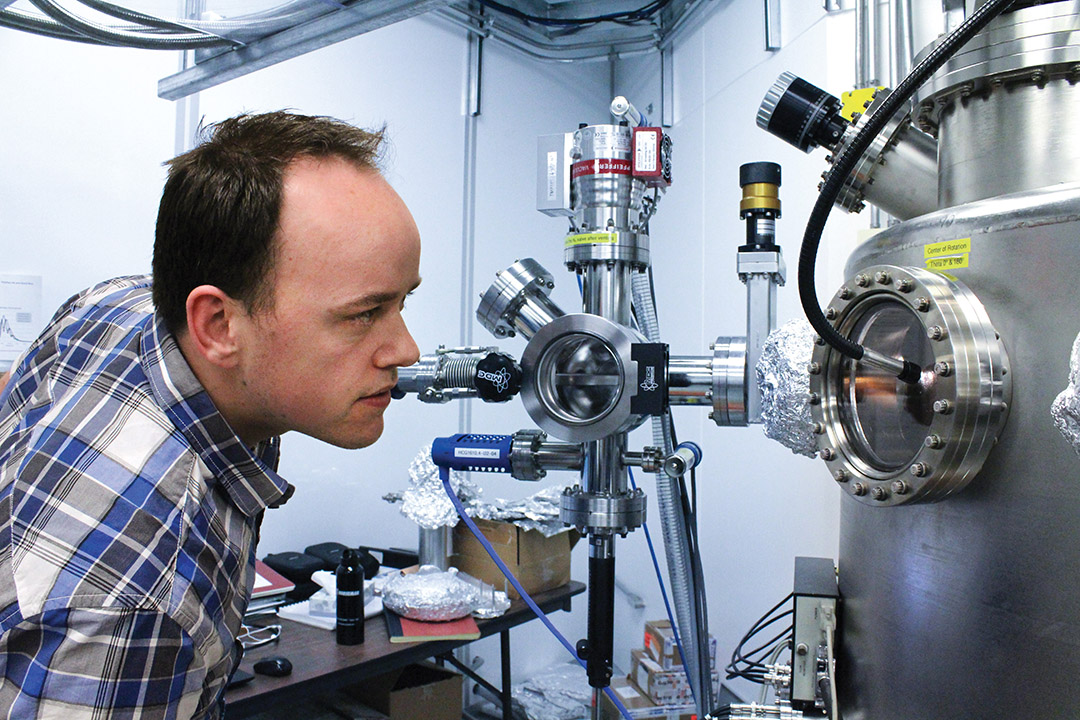The quantum revolution
In October 2019, Google made global headlines with a boast that it had achieved “quantum supremacy.” Its experimental quantum computer had performed in minutes a task that would have taken the world’s fastest supercomputer thousands of years.
By Chris PutnamDr. Steven Rayan (PhD) is director of the Centre for Quantum Topology and its Applications, a USask research centre with a mission to discover the next generation of quantum materials. (Photo: David Stobbe)
For Dr. Steven Rayan (PhD), it was one more sign of what he already knew: the quantum future is close, and Canada needs to be part of it.
“We don’t want to fall behind as a nation in such an important scientific revolution,” said Rayan, a faculty member in the University of Saskatchewan (USask) Department of Mathematics and Statistics. “The idea is to keep Canada at the crest of the wave.”
That mission underlies a new research centre in USask’s College of Arts and Science. At the Centre for Quantum Topology and its Applications (quanTA), Rayan and an alliance of faculty, students and alumni are advancing a scientific frontier that could define our era.
Quantum computers like the machine in Google’s laboratory are just one application of quantum technology. Groundbreaking medicines, improved batteries, miniaturized electronics and new ways of generating electricity could all be on the horizon.
But there is one major obstacle that might grind this innovation to a halt, said Rayan, the director of quanTA.
“The ideas for fantastic new technologies are there, but the materials we use every day—silicon, for instance—simply won't cut it.”
Building the quantum future requires new quantum materials.
Material superpowers
At the most basic level, all matter owes its properties to quantum physics, the interactions that happen at the smallest scales of nature. But in recent decades, scientists have uncovered new states of matter—quantum materials—in which the strange workings of the quantum world reveal themselves in striking ways.
“We’ve understood the phases of matter as being solid, liquid and gaseous. But within the solid phase, there are all kinds of ways that materials can behave,” said Dr. Gordon Sarty (MSc’90, PhD’95), a faculty member of quanTA. “Now there’s an explosion of these different states that people are discovering.”

The family of quantum materials includes superconductors, which have the remarkable ability to conduct electricity with zero loss or resistance. Other quantum materials show similarly spectacular electrical or magnetic qualities that have reshaped our understanding of physics and hold promise for countless new technologies.
There is a catch. The most exciting properties of quantum materials usually only manifest in extreme conditions: under exposure to powerful magnetic fields, for example, or at temperatures colder than Antarctica.
“That’s the problem,” Rayan said. “Have these materials revolutionized condensed matter physics? Yes. Have they revolutionized our lives? No.”
Untapped potential
At universities and private companies around the world, scientists are racing to discover new quantum materials that are practical outside the lab.
The new quanTA centre at USask is one of a handful of such groups in Canada, and its members believe their interdisciplinary strength will be their edge.
One of the most promising classes of quantum materials is topological materials, whose discovery arose from a blend of physics and mathematics that resulted in a Nobel Prize in Physics for three British-American researchers in 2016.
Rayan’s specialties as a mathematician are geometry and topology—the science of shape. The Nobel Prize announcement captured his attention.
Suddenly, “topology was in the news,” and although topological materials weren’t yet part of his research, Rayan’s interest was piqued.
Other researchers at USask—from chemists to physicists to engineers—had been working on quantum materials for years. When Rayan spoke to them, he saw a unique opportunity for collaboration.
“I’ve been very impressed by the culture of interdisciplinarity in the College of Arts and Science. This has really been the perfect setting to do something like this,” he said.
While many laboratories around the world have made progress on topological materials as a physical or engineering problem, Rayan believes the next true breakthrough can only come from another merger of those approaches with mathematics.
In mathematics, he has glimpsed potential for an entirely new class of quantum materials—one much larger than the current family of topological materials—waiting to be discovered.
That idea is the subject of a major research grant Rayan received in 2019 through the federal government’s New Frontiers in Research Fund, which forms part of the funding for quanTA. The Natural Sciences and Engineering Research Council of Canada (NSERC), the Pacific Institute for the Mathematical Sciences and the College of Arts and Science have also invested in the centre.
About 10 faculty members from across the college, together with a growing team of students and postdoctoral fellows, have been finding new ways to work together since quanTA launched in the spring of 2019. Over the next few years, they hope to discover, build and test the next generation of quantum materials.
“I think that by revisiting the foundational mathematics involved in this science, we can take this to the next level. And there really is a next level,” said Rayan.
Challenge of a lifetime
Dr. Robert Green (BSc’09, BE’09, PhD’13) feels lucky to be able to pursue his work close to home.
“For me, I guess I’m a Saskatchewan boy. I was born in the southern part of the province and grew up there. I always wanted to stay here for the long term,” said Green, an assistant professor in the Department of Physics and Engineering Physics.
Green has studied quantum materials throughout his career. He designs and tests the materials to learn what drives their properties and how they might be “tuned” for better performance.
As a faculty member of quanTA, Green says he is excited about the opportunities for collaboration the new centre offers.

Understanding quantum materials is a monumental task, which is part of the appeal for Green. He contrasts them with silicon, the material on which modern transistors, computers and the Information Age were built.
For all its achievements, silicon “is actually a relatively boring material,” Green said. Its electrical properties can be mastered by the average physics student and calculated easily on a desktop computer.
Performing the same simulation of a typical quantum material “would require a computer built using all of the atoms in the universe, and then some,” said Green. Cracking the mysteries beneath those properties is a worthy challenge.
On the USask campus, Green has access to Canada’s synchrotron, the Canadian Light Source (CLS)—a perfect tool for exotic matter research. At the CLS, he bombards samples with X-rays and examines how the rays scatter to better understand the materials’ microscopic nature.
The science is still at a fundamental level, but Green sees his work someday being used in applications like low-powered electronics and neuromorphic computers—computers that behave like a human brain.
“It’s interesting to think what kind of devices might come out of this. If the world of technology we have today came out of boring old silicon, what can we make out of these materials?” said Green.
Space medicine
In a laboratory in the basement of the Arts Building, Sarty’s mind is on the Moon.
The Department of Psychology head, biomedical engineering chair and member of quanTA worked as an engineer before pursuing graduate studies in mathematics at the College of Arts and Science. For the last few years, he and his team have been developing portable magnetic resonance imaging (MRI) machines that could be a major step forward for medical imaging on Earth and beyond.
The Canadian Space Agency—which provides funding for the project along with NSERC—believes these MRIs could be vital tools for preserving the health of astronauts. Sarty’s team is working on an ankle-sized MRI to be tested this fall aboard a jet simulating low-gravity conditions.
If all goes well, the next step will be launching another portable MRI to the International Space Station (ISS), where it will be used to study the health of astronauts in orbit.
To build these devices, Sarty’s team has needed to rethink MRI technology from the ground up. One promising new line of research by USask PhD student Hammed Ejalonibu involves a diamond-based quantum material.
MRIs make use of powerful magnetic fields to create detailed pictures of the human body. Ejalonibu is experimenting with diamonds containing nitrogen vacancies—holes in their structure that trap electrons.
These trapped electrons make the diamonds highly sensitive to magnetic fields. An MRI designed around this material would create images in real time and could be light enough to be handheld, much like a medical ultrasound.
The technology could have applications on Earth, potentially becoming a standard item in emergency rooms or in rural and remote areas.
However, Sarty is first looking to the sky. After the ISS mission, he hopes to put an MRI on the Moon to start gathering the medical data needed to someday send humans to other planets.
“Right now, if we put somebody on a ship to Mars for a year, they would probably die. There’s radiation, their muscles atrophy, their cardiovascular system atrophies. So we need to understand that to figure out how these people are going to survive,” said Sarty. “An MRI will help with that.”
Creating the future
At Sarty’s MRI lab and at locations across the USask campus, a network of students is beginning to share ideas and learn new approaches through quanTA collaborations.
The centre’s goal, said Rayan, is to train future alumni in many scientific languages at once, enabling them to be not just users of quantum technology, but creators. The most transformative applications of quantum materials are probably yet to be imagined.
“We can’t dismiss the value of scientific happenstance. You bring someone a new tool for their toolbox and it’s anyone’s guess what they’ll do with it,” said Rayan.
Whatever the future looks like, Rayan expects quantum materials will define the way we interact with the world around us.
“Our collective history is divided into things like the Bronze Age, the Iron Age. That speaks to the fundamental importance of materials in everything we do and everything we have,” Rayan said. “Maybe the Quantum Age is coming.”

